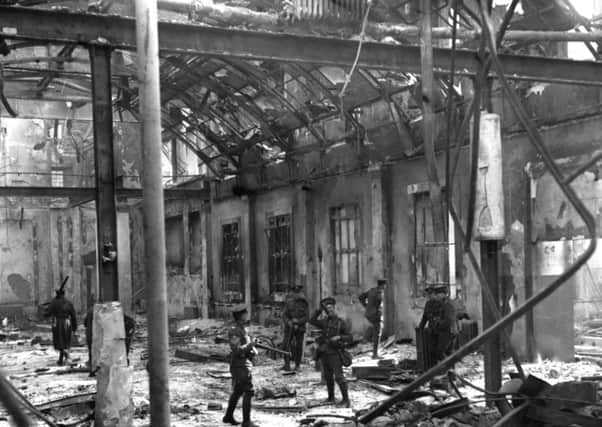Book review: Vivid Faces by RF Foster


Vivid Faces: The Revolutionary Generation in Ireland 1890-1923
RF Foster
Allen Lane, 496pp, £20
The title is, of course from Yeats, the “vivid faces” those of the Easter Rising revolutionaries to whom he nodded in the street or with whom he exchanged “polite, meaningless words” in the days before they marched to the Dublin GPO and changed his world and that “terrible beauty” was born.
Advertisement
Hide AdHis poem Easter 1916 was written out of astonishment. Only a couple of years earlier, Yeats had been telling audiences in the United States that the age of heroism had passed in Ireland. No-one was going to sacrifice their lives for the love of Cathleen Ni Houlihan – the heroine of his eponymous 1902 play and embodiment of an independent Irish state – any more, he claimed. Those days had gone.
Who could say he was wrong? In 1915, John Redmond, the parliamentary nationalist leader, had gone to Wexford, scene of the most bitter fighting in the 1798 rebellion referenced in Yeats’s play, and told a cheering audience that all of their demands had either been met or were about to be. The land question had been solved, religious freedom won, education was free, and home rule was on the statute book, ready to be implemented as soon as Britain won the war against Germany.
The task that RF Foster, doyen of modern Irish historians, has set himself is to delineate what both Yeats and Redmond missed: the formation of a genuinely revolutionary mindset. In doing so, he drills down deeper than the usual explanations, producing insights that have occasional echoes in Scotland’s own, mercifully peaceful, struggle to break the bond with Westminster.
In one of the last poems he wrote before his death in 1938, Yeats wondered out loud “Did that play of mine send out/Certain men the English shot?”. No they didn’t, says Foster. Although conventional analysis emphasises the importance of the Abbey Theatre in inspiring Irish cultural nationalism, by 1916 it looked more like an outpost of the British establishment. The revolutionaries, he argues, were far more influenced by the “mosquito press”, by nationalist pageants, pilgrimages and commemorations, by the polemics and debate and interpretations of Irish history flowing through the columns of the estimated 322 Irish newspapers circulating at the time. These included the Irish Worker (with its circulation of 95,000) the United Irishman, the Spark, Young Ireland. – and, of course, Sinn Fein, selling 8,000 a month by 1911 and edited by Arthur Griffith,who would end up just 11 years later as president of an autonomous Irish state.
The mainspring of the Easter Rising was, of course, the First World War combined with the militarisation of Irish politics in the course of the earlier campaign – strongly resisted in Ulster – for home rule. By 1914, there were 250,000 Irish men and quite a few Irish women were enrolled in paramilitary organisations.
But the questions Foster asks of the past are larger and harder than merely outlining what happened. What makes someone pick up a Lee Enfield and point it at another human being in the cause of nationalism? Why did that matter more than class solidarity? Why was compromise impossible? Why did the impulse to separate from the world’s biggest empire go so deep?
Advertisement
Hide AdFor answers, he goes back to the student literary societies of Ireland’s new universities, to the Gaelic League summer schools, and reconstructs the radical Dublin of Maud Gonne’s feminist journal Bean na hEireann and Tom Clark’s radical newsagent in (ironically enough) Great Britain Street. Self-referencing it may have been, naive too, but there was a heady idealism in such places – and in any case, hadn’t Alexander Herzen already pointed out that successful revolutionaries need “a pure, uncomplicated, childlike quality of thought”?
In unpublished memoir after unpublished memoir, Foster tracks down that idealism – and wonders what kind of country Ireland would have been had this not evaporated in a bloody civil war. “It is impossible not to speculate,” he writes, “how different the Free State would be had it been enshrined more on the educational ideas of Pearce, the organisational genius of McDermott and Collins, the social egalitarianism of Connolly and Mellows, the cultural imagination of MacDonagh and Plunkett and the secularism of the Sheehy-Skiffingtons.”
Advertisement
Hide AdThe new Ireland that emerged instead was fiscally solid, uncorrupt, ordered: it had policemen who didn’t wear guns and a civil service that didn’t take bribes. But it was a boring, priest-ridden, less culturally vibrant place. “The phoenix of our youth has fluttered to earth such a miserable hen,” wrote former Sinn Fein vice-president Bulmer Hobson. Take away all the martyrology, says Foster, and the literature of Irish republican disillusion is vast.
He waits until his conclusion before suggesting one last, fascinating interpretation of the roots of the Rising, quoting with approval the statement by George William Russell (“AE”) that historical oppression mattered far less than “the psychological factor which made the Irish regard the state which inflicted such things upon them as a tyranny by aliens”. The British governments at the time was less tyrannical than most, but that no longer mattered. Maybe, indeed, it was the problem. In the words of one Irish Volunteer in in 1914: “The whole Irish people seemed to have become English and nationality seemed to have become a mere thread ready to break.”
Of course, anyone cycling down to Ballingeary to learn Irish at a Gaelic League summer school would point out that the very language they were learning was proof of that national difference. Perhaps, though, they were only going there in the first place because an anglicised, materialist culture was already on the march and they wanted to emphasise how much they differed from it. Any echoes there, Scotland?